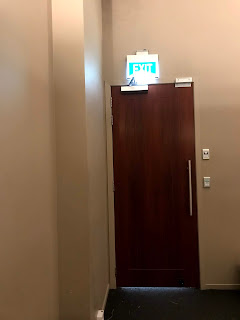Brainstorm:
This was written by my classmate, Luci Crawford. The
ideas were generated by our group, Pill Productions.
Storyboard:
The is the storyboard for our film called 'The Hitman'.
Location:
For our film, we needed to film at two locations this being a room and the toilet for the meeting scene and sink scene. The meeting scene is between the hitman and hirer. We needed the room to be in low lighting to create a dark ambience. For the Flashback scene, the toilet was an important setting it shows the hitman washing the blood off his hands and along with the other clues should present him as feeling remorseful for the murder of a person.
Office:
Originally we planned to use the office room.
We decided to change the location to the salvation room because it was unavailable and was a great distance from our other location, the bathroom.
The Salvation Room:
|
Toilet:
Practising of panning camera from top right to bottom left where the pool of blood will be.
This is how the office room is imagined to
look like:
Rationale:
Plot: Opening scene- the
hitman walks down a hallway and opens a door. He enters the room and sits down
in a chair opposite his hirer. The hirer asks, “Is it done?’, the hitman looks
at his hands and flashbacks to the sink scene. The flashback scene ends, he
clears his throat and replies, “yes”. Then the hirer passes him an envelope
across the table. The scene ends in with the envelope in focus. It ends in
black.
These are the thriller
conventions that will be used in the scene: mirror, shadow, eerie music,
flashback editing and blood. These will be discussed down below.
Camerawork
Principles of continuity
plan:
- Match on
action will be used when the hitman walks into the room from
the hallway
- 180 rule will be used between the hitman and the hirer when
they are sitting in the room across from each other.
- Shot-reverse-shot
will be used when the hirer
slides the envelope across the table towards the hitman and the hitman
taking it from the table. It focuses on the reactions of the hitman and the hirer.
The scene begins with an extreme-wide shot of the hitman slowly walking to the door. He wears a suit which gives him the impression that he is in a position of power. He walks away from the camera so the audience isn't able to see his face. This creates a sense of mystery. The audiences are interested in what is happening and what will happen straight away.
There is a close-up
shot of the hitman putting his thumb onto the scanner to access the room.
He is given access to a place restricted to normal people. This shows the
importance of his character because the scanner shows the room is coded. So the room that he
is entering in is secretive.
There is an extreme wide shot of the hitman walking through the door into the
office. His back is towards the camera, his face still hasn’t been revealed to
the audience yet. The audience still doesn't know much about him it presents him as mysterious.
Lighting
Throughout the clip, the lighting is low to create a dark ambience.
Audio
The scene starts with very
sad and dark music which reflects the hitman’s emotion - the ending
of the scene is left to the audience interpretation of how he felt about taking
someone’s life.
In scene 2 this music
volume gets lower to lead the audience's attention to the hitman washing
the blood off his hands. The hitman is portrayed to be feeling remorseful as
seen with the heartbeat sound effect which shows he is nervous and how
determined he is with washing the blood off his hands. This point in the clip
is the turning point as it should gather the audience’s sympathy towards the hitman.
Suspense music is used
while the hitman is washing his hands. This music becomes more intense to
prepare and frighten the audience when the camera pans to the bottom left where a pool
of blood becomes the main focus.
The intensity of the clip
is gradually built through the choice of music from very dark and sad music to
suspenseful music and eerie music.
The hitman’s dialogue, “yes”, is simple yet dramatic.
Editing
In a flashback scene, the
mirror reflects the hitman washing blood off his hands. The mirror symbolises
reality. Because of the mirror, the hitman is able to see what he has done.
Although the female character’s question, “Is it done?” is vague the audience
are able to find what she means through the male character’s flashback.
Therefore, the editing is able to make up for the weak use of spoken language.
However, if the flashback editing is done right, the lack of spoken language
adds to the mysterious feel which stirs up questions within the audience’s
heads.
Mise en scene
Blood symbolises death. It connotes the
idea of violence.
The bag represents his changing identity.
In it, he puts the different attires he wears presenting himself in different
ways. It suggests he is hiding his two lifestyles as a normal guy which is
symbolised by the hoodie and a hitman.
The knife covered in blood along with the
other clues given to the audience confirms he is an amateur.
The envelope is used to show that the exchange of most likely money has occurred. It tells the audience the male character is a hitman. The camera zooms in on written language, "Mr Smith", before the clip ends in black. Just as the clip began with the male character being the main focus it ends also like that. This link highlights the male character showing that he is the main character and so the hitman.
This is the list of who was assigned what for our group:



















